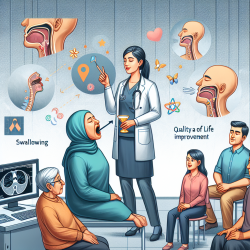Introduction
Understanding the complexities of dysphagia in patients with dementia is crucial for speech-language pathologists aiming to improve clinical outcomes. The study titled "Quantifying Airway Invasion and Pharyngeal Residue in Patients with Dementia" provides valuable insights into the physiological impairments associated with dysphagia in this population. This blog post will explore the key findings of the study and discuss how practitioners can apply these insights to enhance their clinical practice.
Key Findings
The study analyzed videofluoroscopy clips of 58 patients with dementia, focusing on the safety and efficiency of swallowing using the Penetration–Aspiration Scale (PAS) and the Normalized Residue Ratio Scale (NRRS). The results indicated that:
- Over 70% of both thin and extremely thick liquid swallows were deemed safe (PAS < 3).
- Residue was more commonly found in the valleculae than in the pyriform sinuses.
- There was a 2.83 times greater relative risk of penetration–aspiration in the presence of thin liquid pyriform sinus residue.
Clinical Implications
The findings suggest that while a majority of swallows are safe, significant residue, particularly in the pyriform sinuses, poses a risk for airway invasion. Practitioners should consider the following strategies to mitigate these risks:
- Regular Monitoring: Use videofluoroscopy to regularly assess swallowing safety and efficiency in patients with dementia, focusing on residue in the pyriform sinuses.
- Texture Modification: Consider recommending texture-modified foods and liquids to reduce the risk of aspiration, especially for patients with significant pyriform sinus residue.
- Targeted Interventions: Develop individualized therapy plans that address specific physiological impairments, such as reduced pharyngeal constriction or delayed swallow initiation.
Encouraging Further Research
While this study provides important insights, further research is needed to fully understand the underlying physiological impairments causing aspiration and residue in patients with dementia. Practitioners are encouraged to contribute to this body of research by:
- Participating in clinical trials that explore innovative therapeutic approaches.
- Collaborating with researchers to investigate the impact of different types of dementia on swallowing function.
- Exploring the role of sensory impairments in pharyngeal residue and aspiration.
Conclusion
The study "Quantifying Airway Invasion and Pharyngeal Residue in Patients with Dementia" provides a data-driven foundation for improving clinical practice in managing dysphagia in dementia. By implementing the study's findings and pursuing further research, practitioners can enhance the quality of care and outcomes for their patients.
To read the original research paper, please follow this link: Quantifying Airway Invasion and Pharyngeal Residue in Patients with Dementia.










